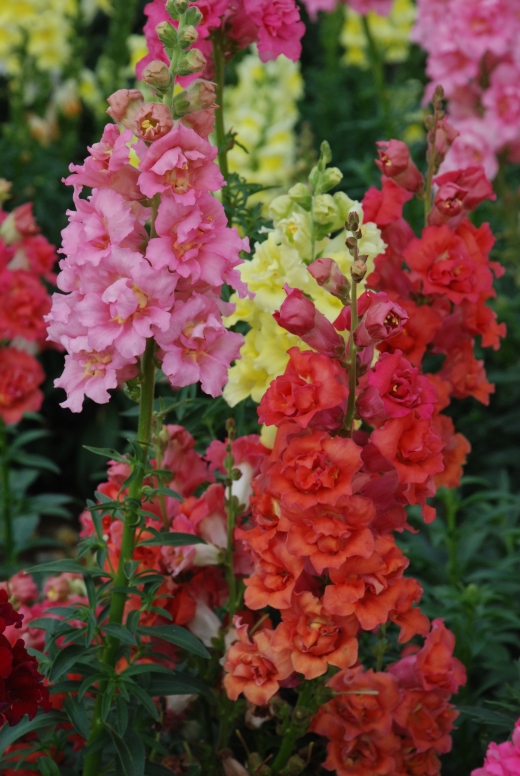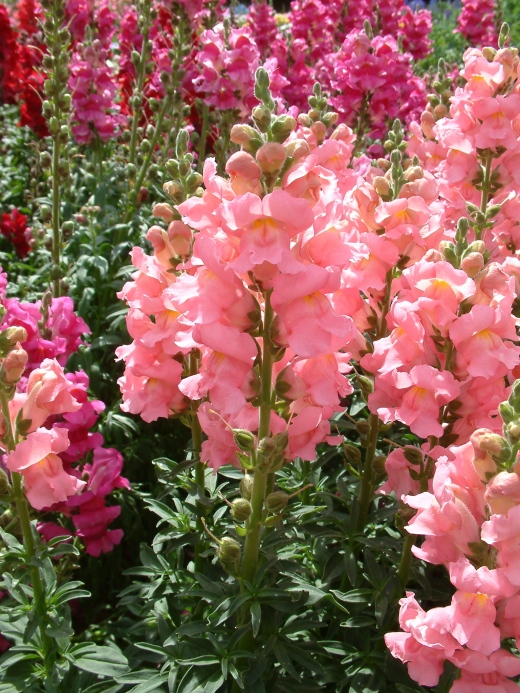Amazing annuals: Antirrhinums
As I get older I am increasingly fond of gool ol’ snap dragons and appreciate their pretty flowers and strong growth. For that reason I tend to prefer and grow the taller kinds and ignore the dwarf kinds that breeders seem obsessed with. Of course, snap dragons (Antirrhinum majus) are not really annuals. They are short-lived perennials that grow wild in dry, rocky places and they can be propagated by cuttings.

As a child I was fascinated by the way the flowers could be manipulated to open their mouths, squeezing the sides behind the flower. They are pollinated by large bumblebees which are heavy enough to weigh down the lower lip of the flower. Small bees are unable to manage this and it is distressing to see them struggle to get in. But often they are quick learners and often bite through the back of the flower to get to the nectar, something they often do to salvias and fuchsias.
A curious feature of many Plantaginaceae ( formerly Scrophulariaceae) is that the flowers, which are composed of five petals fused into a tube, with a distinct lower petal or lip, produce plants with flowers composed of five, identical, lower petals. Such flowers are said to be peloric and in antirrhinums the flowers have an open centre and are trumpet shaped. And then there are doubles, with flowers stuffed with petals. Neither of these, and the last especially, are of much use to pollinators. So it is strange that one of my favourites is the blend of colours called F1 ‘Madame Butterfly’. I should dislike these but they are tall, fragrant and superb for cutting and I grow them at least once every two years.

These and other tall kinds flower right until the frosts of autumn and, in good soil, will survive a mild winter. The dwarf kinds are not so permanent. Because they flower early, on every available sideshoot there is simply nothing left to grow once the main flush is over. They have their use I guess but I have no need of them.
William Robinson wrote ‘ A numerous family of rock plats and perennial herbs, mostly hardy and many of them from mountainous regions, but none so popular in gardens as the handsome Snapdragon.’ ‘The garden varieties are now numerous, and often showy in effect, the best being the pure colours (ie. not striped).’ Striped snapdragons are not that common these days – the best known was possibly a mix called ‘Brighton Rock’. This name now seems to be used for a mix of bicolours which are not striped. But ‘Picasso Splash’ is a good alternative and ‘Purple Twist’ F1 a gorgeous thing with deep pink and purple blooms on tall stems.
Robinson also recommends sowing at three times of year: In August where they are to grow, in June and July to plant out in spring and in March or April. We tend to only sow in spring though sowing some in summer has a lot to commend it, planting in a polytunnel to bloom in spring and early summer. Antirrhinums are the most cold-tolerant of all the annuals we grow and young plants can be put into their flowering positions in May, a month before the rest.

Despite their vigour when mature, seedlings are tiny and very delicate. Partly because they take a long time to bloom from seed and partly to get them out of the greenhouse to make room for later plants in spring, antirrhinums are often sown in February, before most bedding. This is a good plan but has a risk. The seedlings are extremely prone to damping off disease so need great care. To prevent the disease you must use new pots and trays and fresh compost. Sow the seeds in several pots so if one is affected you still have some seedlings. Add extra perlite to the compost to aid drainage and give the seedlings light and air as soon as they germinate. Never overwater them and never use water from a butt. In my youth, at the garden centre where I worked we routinely sprayed and soaked the plants in fungicide but such practice is not suitable for the home gardener.
Snapdragons are not commonly sold as bedding plants except as potted plants of the dwarf kinds or large plants in bloom in summer as fillers. They are well worth growing from seed. The price varies hugely according to whether they are ordinary hybrid strains or F1 hybrids. I have grown some old, single-coloured strains which have been, to be honest, perfectly satisfactory, though not 100% true to type. These were from Chiltern seeds and you get hundreds of seeds in a pack. On the other hand the F1 hybrids can cost 5-10 cents a seed. The good thing about not having too many seeds is that you are far less likely to sow too thickly – one of the contributory factors to damping off disease.
I have not grown these in MANY years, at least in my home garden. They rust so badly. However, they do quite well here, and self sow. They get rust, but do not succumb to it until about now. By this time the next generation is already getting started. They are warm season annuals here, but those that start now can last through winter, and succumb to warmth in spring, just as the next batch is starting for summer.
Rust can be an issue here too though I am pleased to say that rust was not a problem this year. It tends to be less destructive than hollyhock rust. There is a ‘rust-resistant’ mixture that is sold but like most resistant strains I doubt it would be immune.
It need not be totally immune if it can still perform adequately while afflicted, like the crape myrtles that tolerate mildew.
Loved this post! Snaps are definitely one of my favorites. I’m trying the “Madame Butterfly” for the first time this year, but always grow the Liberty series and at least one little dwarf (usually Twinny or a Montego) for very early containers and path edges.
Thank you. I am sure you will enjoy ‘Madame Butterfly’ too – they often smell as good as they look.